2017 FORD SUPER DUTY traction control
[x] Cancel search: traction controlPage 377 of 636
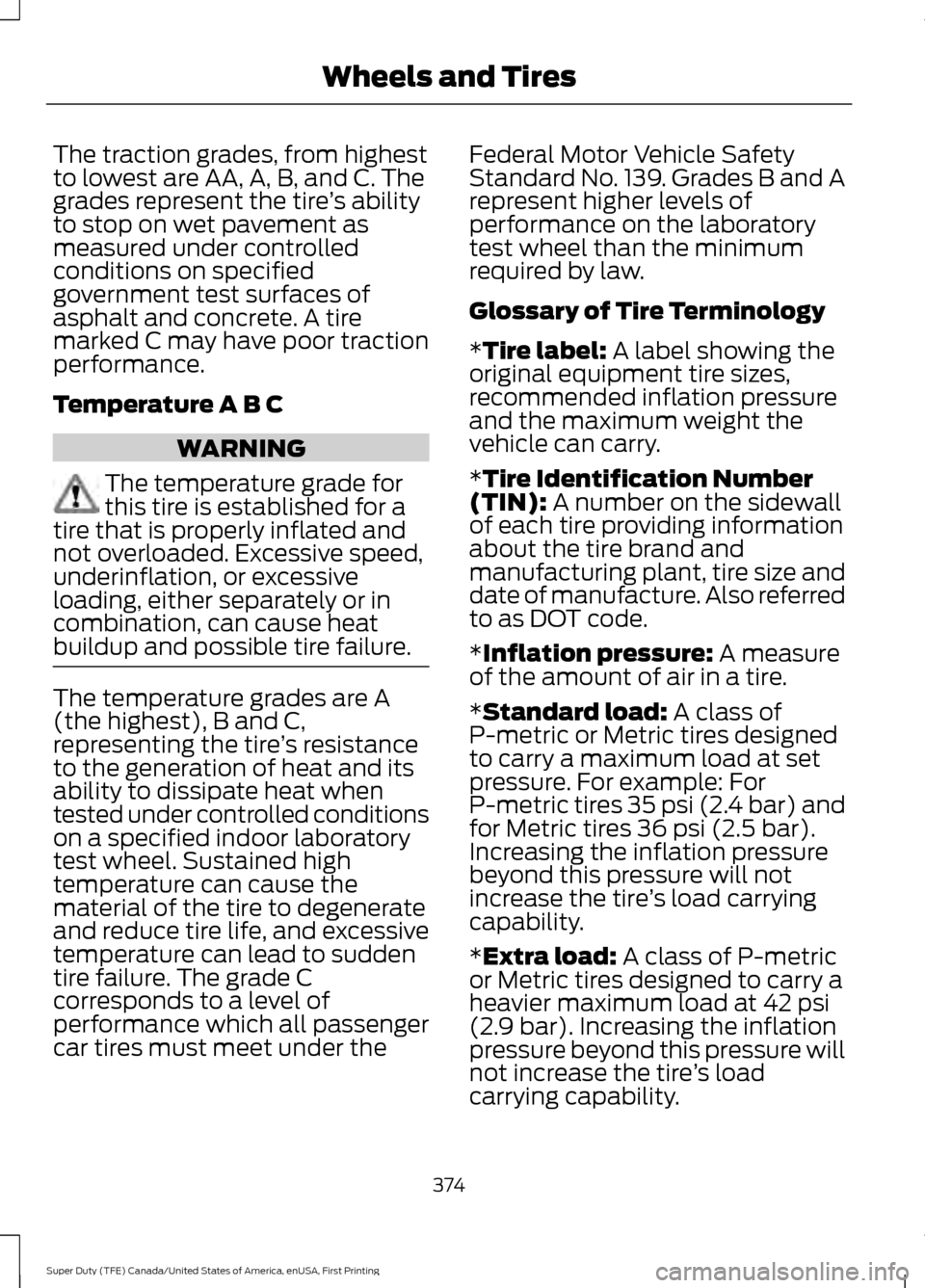
The traction grades, from highest
to lowest are AA, A, B, and C. The
grades represent the tire
’s ability
to stop on wet pavement as
measured under controlled
conditions on specified
government test surfaces of
asphalt and concrete. A tire
marked C may have poor traction
performance.
Temperature A B C WARNING
The temperature grade for
this tire is established for a
tire that is properly inflated and
not overloaded. Excessive speed,
underinflation, or excessive
loading, either separately or in
combination, can cause heat
buildup and possible tire failure. The temperature grades are A
(the highest), B and C,
representing the tire
’s resistance
to the generation of heat and its
ability to dissipate heat when
tested under controlled conditions
on a specified indoor laboratory
test wheel. Sustained high
temperature can cause the
material of the tire to degenerate
and reduce tire life, and excessive
temperature can lead to sudden
tire failure. The grade C
corresponds to a level of
performance which all passenger
car tires must meet under the Federal Motor Vehicle Safety
Standard No. 139. Grades B and A
represent higher levels of
performance on the laboratory
test wheel than the minimum
required by law.
Glossary of Tire Terminology
*Tire label: A label showing the
original equipment tire sizes,
recommended inflation pressure
and the maximum weight the
vehicle can carry.
*
Tire Identification Number
(TIN): A number on the sidewall
of each tire providing information
about the tire brand and
manufacturing plant, tire size and
date of manufacture. Also referred
to as DOT code.
*
Inflation pressure: A measure
of the amount of air in a tire.
*
Standard load: A class of
P-metric or Metric tires designed
to carry a maximum load at set
pressure. For example: For
P-metric tires
35 psi (2.4 bar) and
for Metric tires 36 psi (2.5 bar).
Increasing the inflation pressure
beyond this pressure will not
increase the tire ’s load carrying
capability.
*
Extra load: A class of P-metric
or Metric tires designed to carry a
heavier maximum load at
42 psi
(2.9 bar). Increasing the inflation
pressure beyond this pressure will
not increase the tire ’s load
carrying capability.
374
Super Duty (TFE) Canada/United States of America, enUSA, First Printing Wheels and Tires
Page 380 of 636
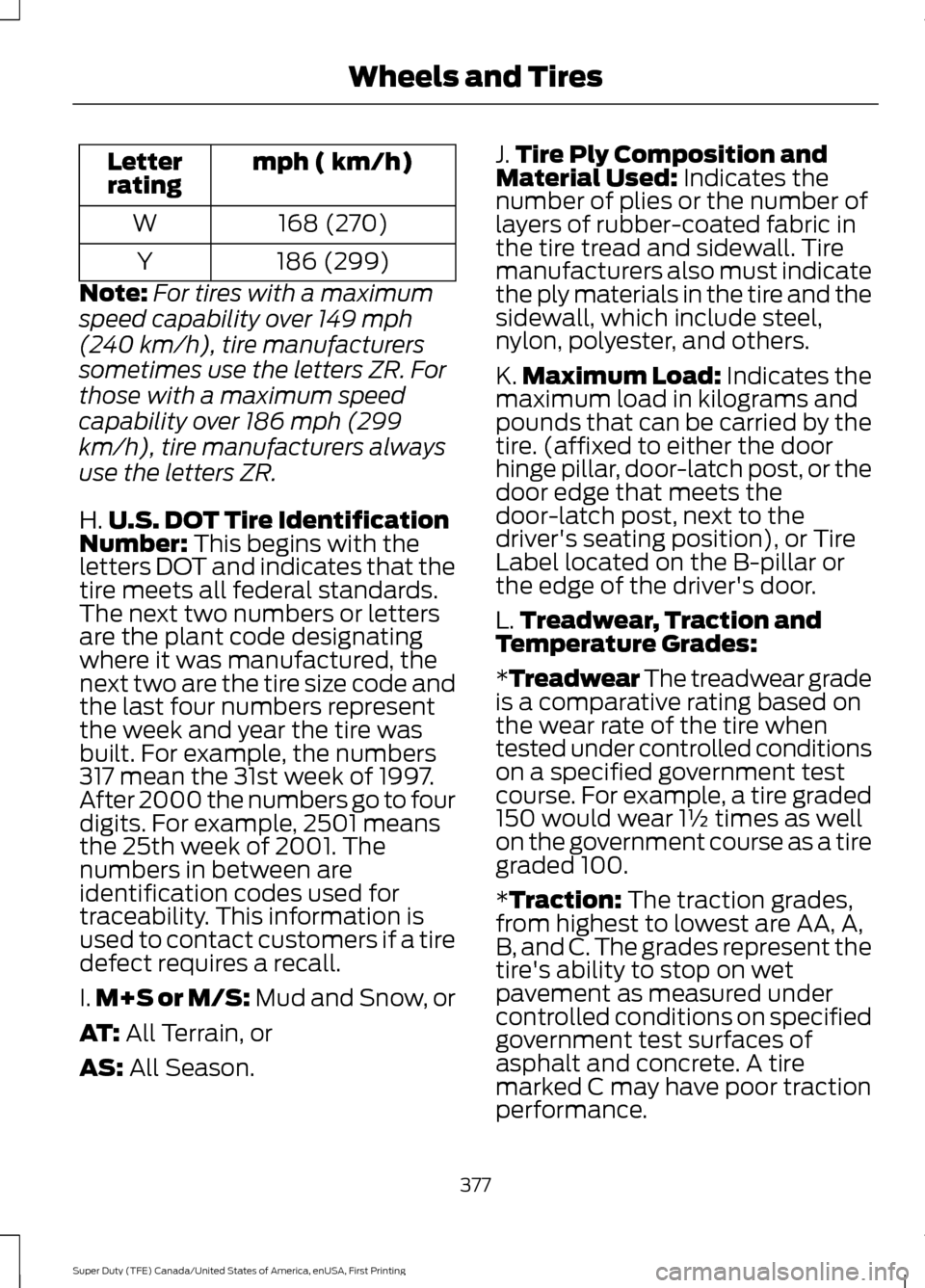
mph ( km/h)
Letter
rating
168 (270)
W
186 (299)
Y
Note: For tires with a maximum
speed capability over 149 mph
(240 km/h), tire manufacturers
sometimes use the letters ZR. For
those with a maximum speed
capability over 186 mph (299
km/h), tire manufacturers always
use the letters ZR.
H. U.S. DOT Tire Identification
Number: This begins with the
letters DOT and indicates that the
tire meets all federal standards.
The next two numbers or letters
are the plant code designating
where it was manufactured, the
next two are the tire size code and
the last four numbers represent
the week and year the tire was
built. For example, the numbers
317 mean the 31st week of 1997.
After 2000 the numbers go to four
digits. For example, 2501 means
the 25th week of 2001. The
numbers in between are
identification codes used for
traceability. This information is
used to contact customers if a tire
defect requires a recall.
I. M+S or M/S:
Mud and Snow, or
AT:
All Terrain, or
AS:
All Season. J.
Tire Ply Composition and
Material Used:
Indicates the
number of plies or the number of
layers of rubber-coated fabric in
the tire tread and sidewall. Tire
manufacturers also must indicate
the ply materials in the tire and the
sidewall, which include steel,
nylon, polyester, and others.
K. Maximum Load: Indicates the
maximum load in kilograms and
pounds that can be carried by the
tire. (affixed to either the door
hinge pillar, door-latch post, or the
door edge that meets the
door-latch post, next to the
driver's seating position), or Tire
Label located on the B-pillar or
the edge of the driver's door.
L. Treadwear, Traction and
Temperature Grades:
*Treadwear The treadwear grade
is a comparative rating based on
the wear rate of the tire when
tested under controlled conditions
on a specified government test
course. For example, a tire graded
150 would wear 1½ times as well
on the government course as a tire
graded 100.
*
Traction: The traction grades,
from highest to lowest are AA, A,
B, and C. The grades represent the
tire's ability to stop on wet
pavement as measured under
controlled conditions on specified
government test surfaces of
asphalt and concrete. A tire
marked C may have poor traction
performance.
377
Super Duty (TFE) Canada/United States of America, enUSA, First Printing Wheels and Tires
Page 393 of 636
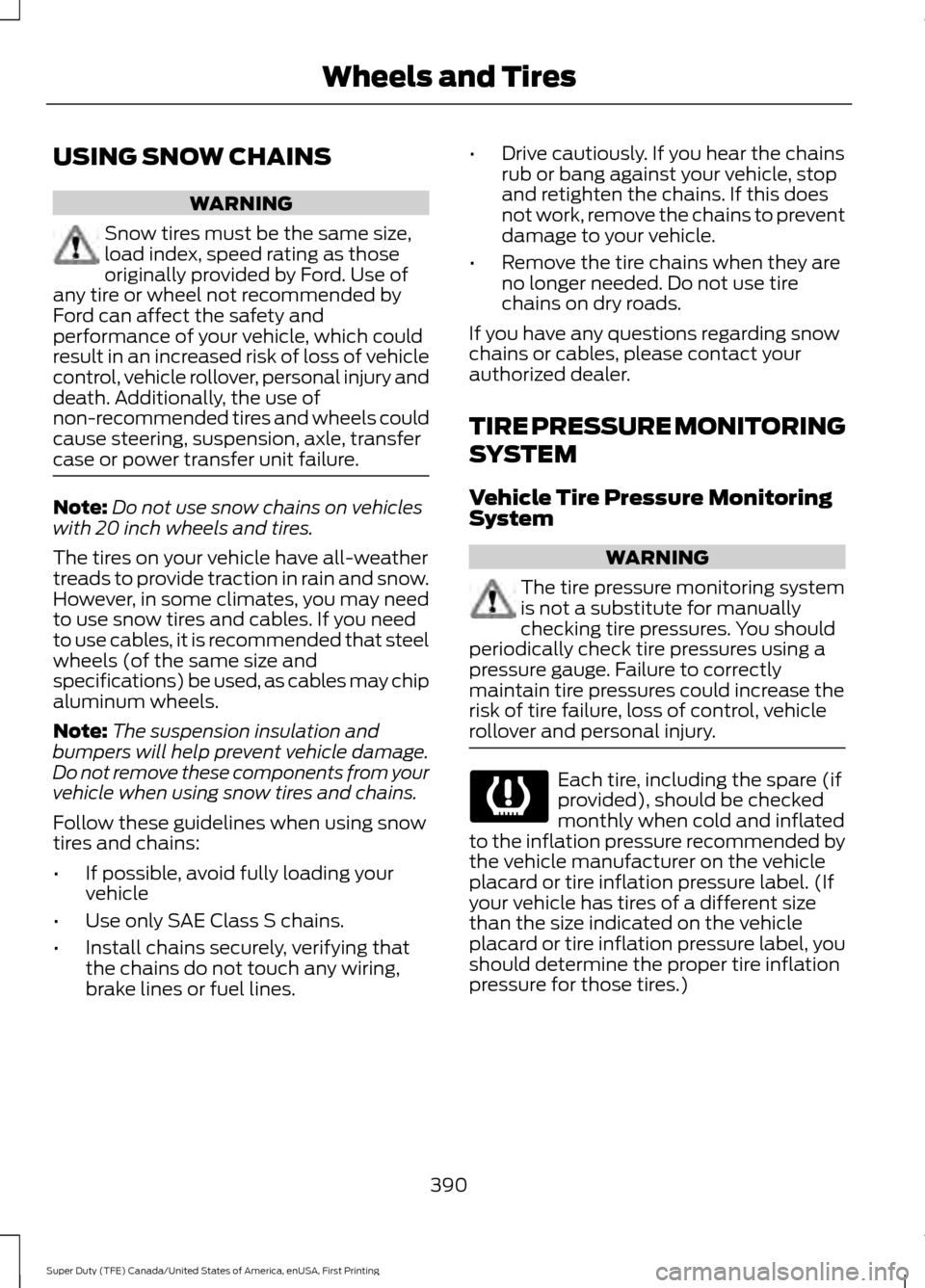
USING SNOW CHAINS
WARNING
Snow tires must be the same size,
load index, speed rating as those
originally provided by Ford. Use of
any tire or wheel not recommended by
Ford can affect the safety and
performance of your vehicle, which could
result in an increased risk of loss of vehicle
control, vehicle rollover, personal injury and
death. Additionally, the use of
non-recommended tires and wheels could
cause steering, suspension, axle, transfer
case or power transfer unit failure. Note:
Do not use snow chains on vehicles
with 20 inch wheels and tires.
The tires on your vehicle have all-weather
treads to provide traction in rain and snow.
However, in some climates, you may need
to use snow tires and cables. If you need
to use cables, it is recommended that steel
wheels (of the same size and
specifications) be used, as cables may chip
aluminum wheels.
Note: The suspension insulation and
bumpers will help prevent vehicle damage.
Do not remove these components from your
vehicle when using snow tires and chains.
Follow these guidelines when using snow
tires and chains:
• If possible, avoid fully loading your
vehicle
• Use only SAE Class S chains.
• Install chains securely, verifying that
the chains do not touch any wiring,
brake lines or fuel lines. •
Drive cautiously. If you hear the chains
rub or bang against your vehicle, stop
and retighten the chains. If this does
not work, remove the chains to prevent
damage to your vehicle.
• Remove the tire chains when they are
no longer needed. Do not use tire
chains on dry roads.
If you have any questions regarding snow
chains or cables, please contact your
authorized dealer.
TIRE PRESSURE MONITORING
SYSTEM
Vehicle Tire Pressure Monitoring
System WARNING
The tire pressure monitoring system
is not a substitute for manually
checking tire pressures. You should
periodically check tire pressures using a
pressure gauge. Failure to correctly
maintain tire pressures could increase the
risk of tire failure, loss of control, vehicle
rollover and personal injury. Each tire, including the spare (if
provided), should be checked
monthly when cold and inflated
to the inflation pressure recommended by
the vehicle manufacturer on the vehicle
placard or tire inflation pressure label. (If
your vehicle has tires of a different size
than the size indicated on the vehicle
placard or tire inflation pressure label, you
should determine the proper tire inflation
pressure for those tires.)
390
Super Duty (TFE) Canada/United States of America, enUSA, First Printing Wheels and Tires
Page 587 of 636
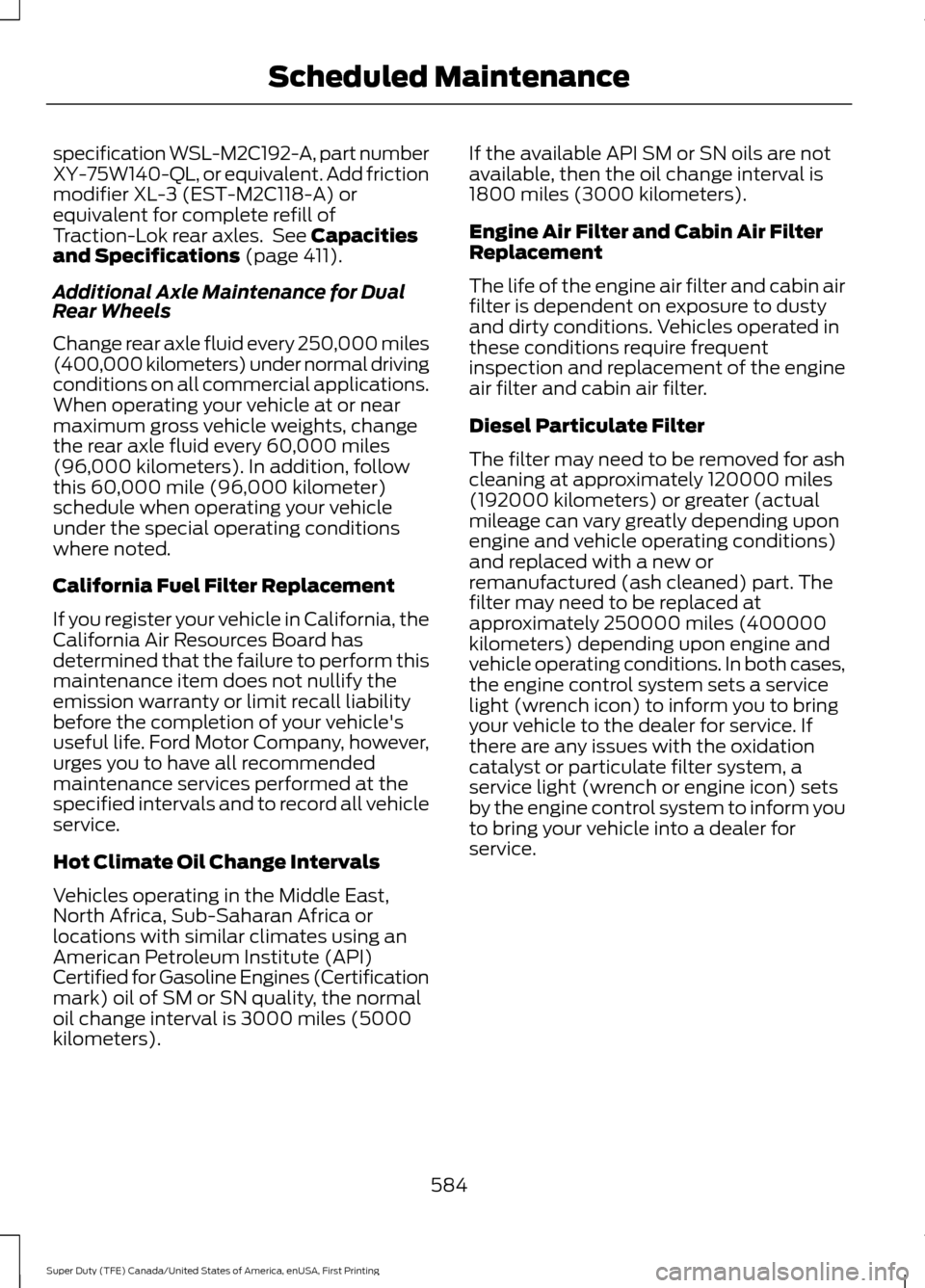
specification WSL-M2C192-A, part number
XY-75W140-QL, or equivalent. Add friction
modifier XL-3 (EST-M2C118-A) or
equivalent for complete refill of
Traction-Lok rear axles. See Capacities
and Specifications (page 411).
Additional Axle Maintenance for Dual
Rear Wheels
Change rear axle fluid every 250,000 miles
(400,000 kilometers) under normal driving
conditions on all commercial applications.
When operating your vehicle at or near
maximum gross vehicle weights, change
the rear axle fluid every 60,000 miles
(96,000 kilometers). In addition, follow
this 60,000 mile (96,000 kilometer)
schedule when operating your vehicle
under the special operating conditions
where noted.
California Fuel Filter Replacement
If you register your vehicle in California, the
California Air Resources Board has
determined that the failure to perform this
maintenance item does not nullify the
emission warranty or limit recall liability
before the completion of your vehicle's
useful life. Ford Motor Company, however,
urges you to have all recommended
maintenance services performed at the
specified intervals and to record all vehicle
service.
Hot Climate Oil Change Intervals
Vehicles operating in the Middle East,
North Africa, Sub-Saharan Africa or
locations with similar climates using an
American Petroleum Institute (API)
Certified for Gasoline Engines (Certification
mark) oil of SM or SN quality, the normal
oil change interval is 3000 miles (5000
kilometers). If the available API SM or SN oils are not
available, then the oil change interval is
1800 miles (3000 kilometers).
Engine Air Filter and Cabin Air Filter
Replacement
The life of the engine air filter and cabin air
filter is dependent on exposure to dusty
and dirty conditions. Vehicles operated in
these conditions require frequent
inspection and replacement of the engine
air filter and cabin air filter.
Diesel Particulate Filter
The filter may need to be removed for ash
cleaning at approximately 120000 miles
(192000 kilometers) or greater (actual
mileage can vary greatly depending upon
engine and vehicle operating conditions)
and replaced with a new or
remanufactured (ash cleaned) part. The
filter may need to be replaced at
approximately 250000 miles (400000
kilometers) depending upon engine and
vehicle operating conditions. In both cases,
the engine control system sets a service
light (wrench icon) to inform you to bring
your vehicle to the dealer for service. If
there are any issues with the oxidation
catalyst or particulate filter system, a
service light (wrench or engine icon) sets
by the engine control system to inform you
to bring your vehicle into a dealer for
service.
584
Super Duty (TFE) Canada/United States of America, enUSA, First Printing Scheduled Maintenance
Page 601 of 636
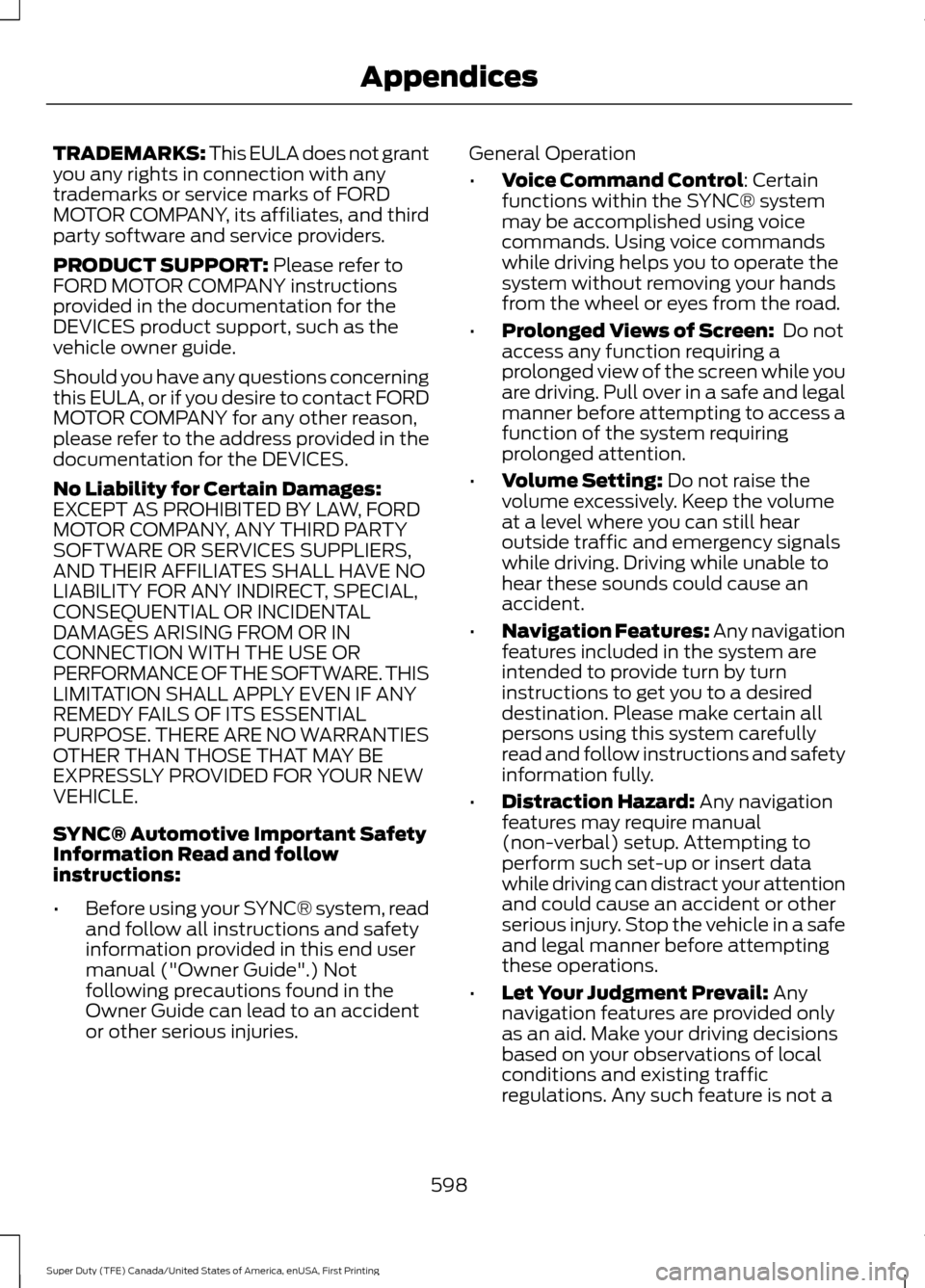
TRADEMARKS: This EULA does not grant
you any rights in connection with any
trademarks or service marks of FORD
MOTOR COMPANY, its affiliates, and third
party software and service providers.
PRODUCT SUPPORT: Please refer to
FORD MOTOR COMPANY instructions
provided in the documentation for the
DEVICES product support, such as the
vehicle owner guide.
Should you have any questions concerning
this EULA, or if you desire to contact FORD
MOTOR COMPANY for any other reason,
please refer to the address provided in the
documentation for the DEVICES.
No Liability for Certain Damages:
EXCEPT AS PROHIBITED BY LAW, FORD
MOTOR COMPANY, ANY THIRD PARTY
SOFTWARE OR SERVICES SUPPLIERS,
AND THEIR AFFILIATES SHALL HAVE NO
LIABILITY FOR ANY INDIRECT, SPECIAL,
CONSEQUENTIAL OR INCIDENTAL
DAMAGES ARISING FROM OR IN
CONNECTION WITH THE USE OR
PERFORMANCE OF THE SOFTWARE. THIS
LIMITATION SHALL APPLY EVEN IF ANY
REMEDY FAILS OF ITS ESSENTIAL
PURPOSE. THERE ARE NO WARRANTIES
OTHER THAN THOSE THAT MAY BE
EXPRESSLY PROVIDED FOR YOUR NEW
VEHICLE.
SYNC® Automotive Important Safety
Information Read and follow
instructions:
• Before using your SYNC® system, read
and follow all instructions and safety
information provided in this end user
manual ("Owner Guide".) Not
following precautions found in the
Owner Guide can lead to an accident
or other serious injuries. General Operation
•
Voice Command Control
: Certain
functions within the SYNC® system
may be accomplished using voice
commands. Using voice commands
while driving helps you to operate the
system without removing your hands
from the wheel or eyes from the road.
• Prolonged Views of Screen:
Do not
access any function requiring a
prolonged view of the screen while you
are driving. Pull over in a safe and legal
manner before attempting to access a
function of the system requiring
prolonged attention.
• Volume Setting:
Do not raise the
volume excessively. Keep the volume
at a level where you can still hear
outside traffic and emergency signals
while driving. Driving while unable to
hear these sounds could cause an
accident.
• Navigation Features:
Any navigation
features included in the system are
intended to provide turn by turn
instructions to get you to a desired
destination. Please make certain all
persons using this system carefully
read and follow instructions and safety
information fully.
• Distraction Hazard:
Any navigation
features may require manual
(non-verbal) setup. Attempting to
perform such set-up or insert data
while driving can distract your attention
and could cause an accident or other
serious injury. Stop the vehicle in a safe
and legal manner before attempting
these operations.
• Let Your Judgment Prevail:
Any
navigation features are provided only
as an aid. Make your driving decisions
based on your observations of local
conditions and existing traffic
regulations. Any such feature is not a
598
Super Duty (TFE) Canada/United States of America, enUSA, First Printing Appendices
Page 629 of 636
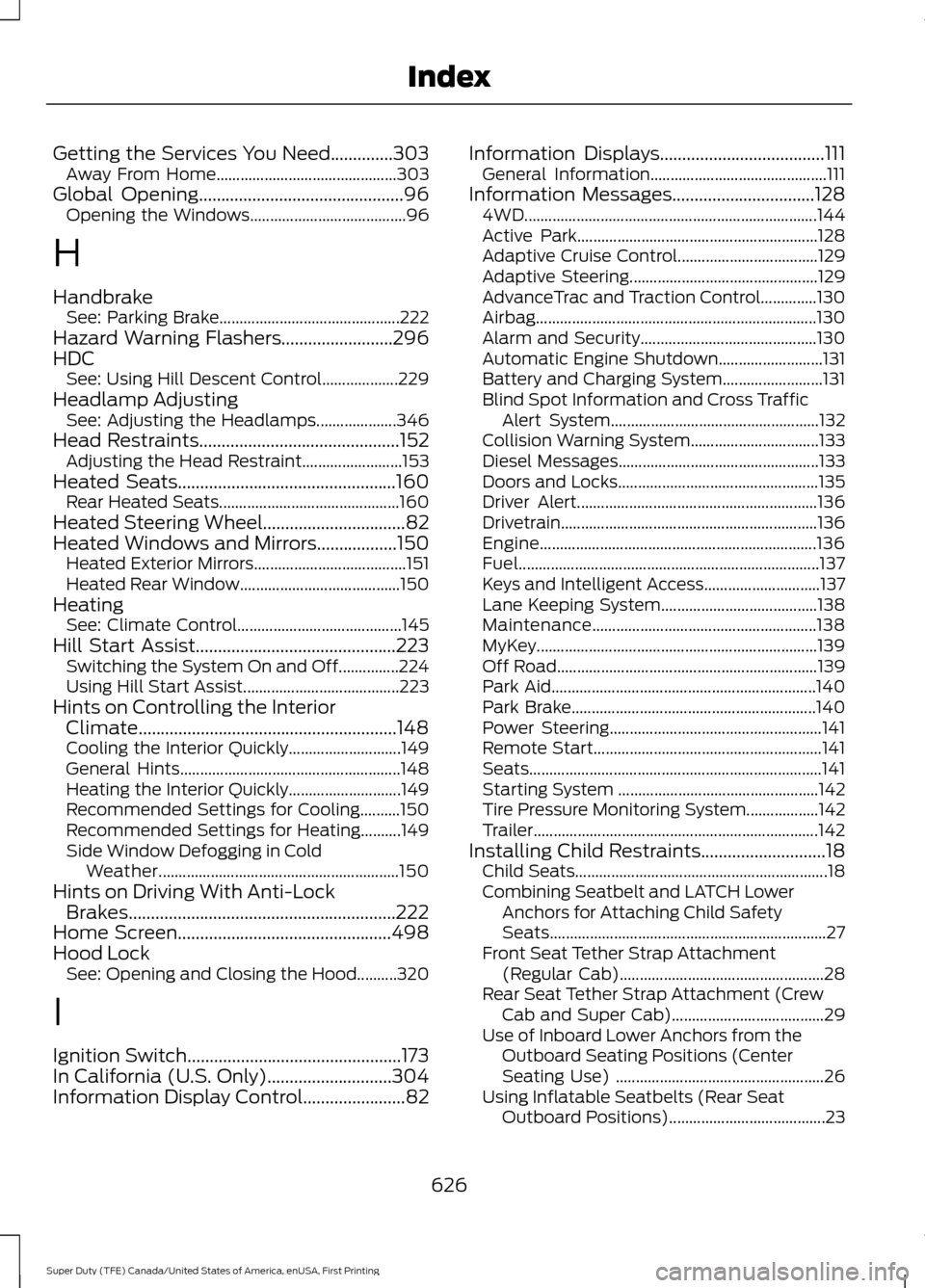
Getting the Services You Need..............303
Away From Home............................................. 303
Global Opening
..............................................96
Opening the Windows....................................... 96
H
Handbrake See: Parking Brake............................................. 222
Hazard Warning Flashers.........................296
HDC See: Using Hill Descent Control................... 229
Headlamp Adjusting See: Adjusting the Headlamps.................... 346
Head Restraints
.............................................152
Adjusting the Head Restraint......................... 153
Heated Seats.................................................160 Rear Heated Seats............................................. 160
Heated Steering Wheel
................................82
Heated Windows and Mirrors..................150 Heated Exterior Mirrors...................................... 151
Heated Rear Window........................................ 150
Heating See: Climate Control......................................... 145
Hill Start Assist
.............................................223
Switching the System On and Off...............224
Using Hill Start Assist....................................... 223
Hints on Controlling the Interior Climate..........................................................148
Cooling the Interior Quickly............................ 149
General Hints....................................................... 148
Heating the Interior Quickly............................ 149
Recommended Settings for Cooling..........150
Recommended Settings for Heating..........149
Side Window Defogging in Cold Weather............................................................ 150
Hints on Driving With Anti-Lock Brakes............................................................222
Home Screen................................................498
Hood Lock See: Opening and Closing the Hood..........320
I
Ignition Switch
................................................173
In California (U.S. Only)............................304
Information Display Control
.......................82 Information Displays.....................................111
General Information............................................ 111
Information Messages
................................128
4WD........................................................................\
. 144
Active Park............................................................ 128
Adaptive Cruise Control................................... 129
Adaptive Steering............................................... 129
AdvanceTrac and Traction Control..............130
Airbag...................................................................... 130
Alarm and Security............................................ 130
Automatic Engine Shutdown.......................... 131
Battery and Charging System......................... 131
Blind Spot Information and Cross Traffic Alert System.................................................... 132
Collision Warning System................................ 133
Diesel Messages.................................................. 133
Doors and Locks.................................................. 135
Driver Alert............................................................ 136
Drivetrain................................................................ 136
Engine..................................................................... 136
Fuel........................................................................\
... 137
Keys and Intelligent Access............................. 137
Lane Keeping System....................................... 138
Maintenance........................................................ 138
MyKey...................................................................... 139
Off Road................................................................. 139
Park Aid.................................................................. 140
Park Brake............................................................. 140
Power Steering..................................................... 141
Remote Start......................................................... 141
Seats........................................................................\
. 141
Starting System .................................................. 142
Tire Pressure Monitoring System.................. 142
Trailer....................................................................... 142
Installing Child Restraints
............................18
Child Seats............................................................... 18
Combining Seatbelt and LATCH Lower Anchors for Attaching Child Safety
Seats..................................................................... 27
Front Seat Tether Strap Attachment (Regular Cab)................................................... 28
Rear Seat Tether Strap Attachment (Crew Cab and Super Cab)...................................... 29
Use of Inboard Lower Anchors from the Outboard Seating Positions (Center
Seating Use) .................................................... 26
Using Inflatable Seatbelts (Rear Seat Outboard Positions)....................................... 23
626
Super Duty (TFE) Canada/United States of America, enUSA, First Printing Index
Page 634 of 636
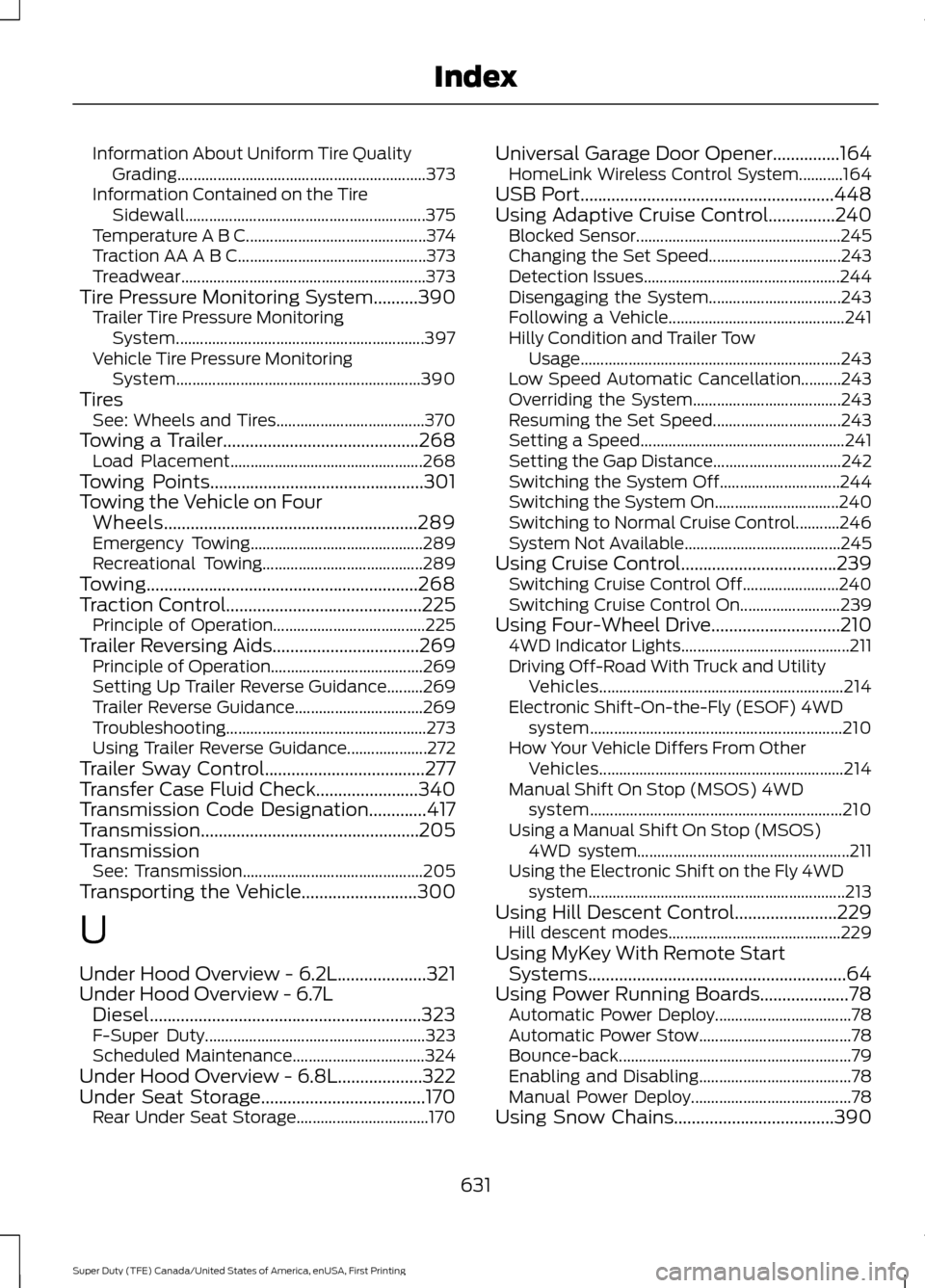
Information About Uniform Tire Quality
Grading.............................................................. 373
Information Contained on the Tire Sidewall............................................................ 375
Temperature A B C............................................. 374
Traction AA A B C............................................... 373
Treadwear............................................................. 373
Tire Pressure Monitoring System..........390
Trailer Tire Pressure Monitoring
System.............................................................. 397
Vehicle Tire Pressure Monitoring System............................................................. 390
Tires See: Wheels and Tires..................................... 370
Towing a Trailer............................................268 Load Placement................................................ 268
Towing Points................................................301
Towing the Vehicle on Four Wheels.........................................................289
Emergency Towing........................................... 289
Recreational Towing........................................ 289
Towing.............................................................268
Traction Control
............................................225
Principle of Operation...................................... 225
Trailer Reversing Aids.................................269 Principle of Operation...................................... 269
Setting Up Trailer Reverse Guidance.........269
Trailer Reverse Guidance................................ 269
Troubleshooting.................................................. 273
Using Trailer Reverse Guidance....................272
Trailer Sway Control
....................................277
Transfer Case Fluid Check.......................340
Transmission Code Designation.............417
Transmission.................................................205
Transmission See: Transmission............................................. 205
Transporting the Vehicle
..........................300
U
Under Hood Overview - 6.2L....................321
Under Hood Overview - 6.7L Diesel.............................................................323
F-Super Duty....................................................... 323
Scheduled Maintenance................................. 324
Under Hood Overview - 6.8L...................322
Under Seat Storage.....................................170 Rear Under Seat Storage................................. 170Universal Garage Door Opener...............164
HomeLink Wireless Control System...........164
USB Port.........................................................448
Using Adaptive Cruise Control
...............240
Blocked Sensor................................................... 245
Changing the Set Speed................................. 243
Detection Issues................................................. 244
Disengaging the System................................. 243
Following a Vehicle............................................ 241
Hilly Condition and Trailer Tow Usage................................................................. 243
Low Speed Automatic Cancellation..........243
Overriding the System..................................... 243
Resuming the Set Speed................................ 243
Setting a Speed................................................... 241
Setting the Gap Distance................................ 242
Switching the System Off.............................. 244
Switching the System On............................... 240
Switching to Normal Cruise Control...........246
System Not Available....................................... 245
Using Cruise Control...................................239 Switching Cruise Control Off........................240
Switching Cruise Control On......................... 239
Using Four-Wheel Drive.............................210 4WD Indicator Lights.......................................... 211
Driving Off-Road With Truck and Utility Vehicles............................................................. 214
Electronic Shift-On-the-Fly (ESOF) 4WD system............................................................... 210
How Your Vehicle Differs From Other Vehicles............................................................. 214
Manual Shift On Stop (MSOS) 4WD system............................................................... 210
Using a Manual Shift On Stop (MSOS) 4WD system..................................................... 211
Using the Electronic Shift on the Fly 4WD system................................................................ 213
Using Hill Descent Control.......................229 Hill descent modes........................................... 229
Using MyKey With Remote Start Systems..........................................................64
Using Power Running Boards....................78 Automatic Power Deploy.................................. 78
Automatic Power Stow...................................... 78
Bounce-back.......................................................... 79
Enabling and Disabling...................................... 78
Manual Power Deploy........................................ 78
Using Snow Chains....................................390
631
Super Duty (TFE) Canada/United States of America, enUSA, First Printing Index
Page 635 of 636
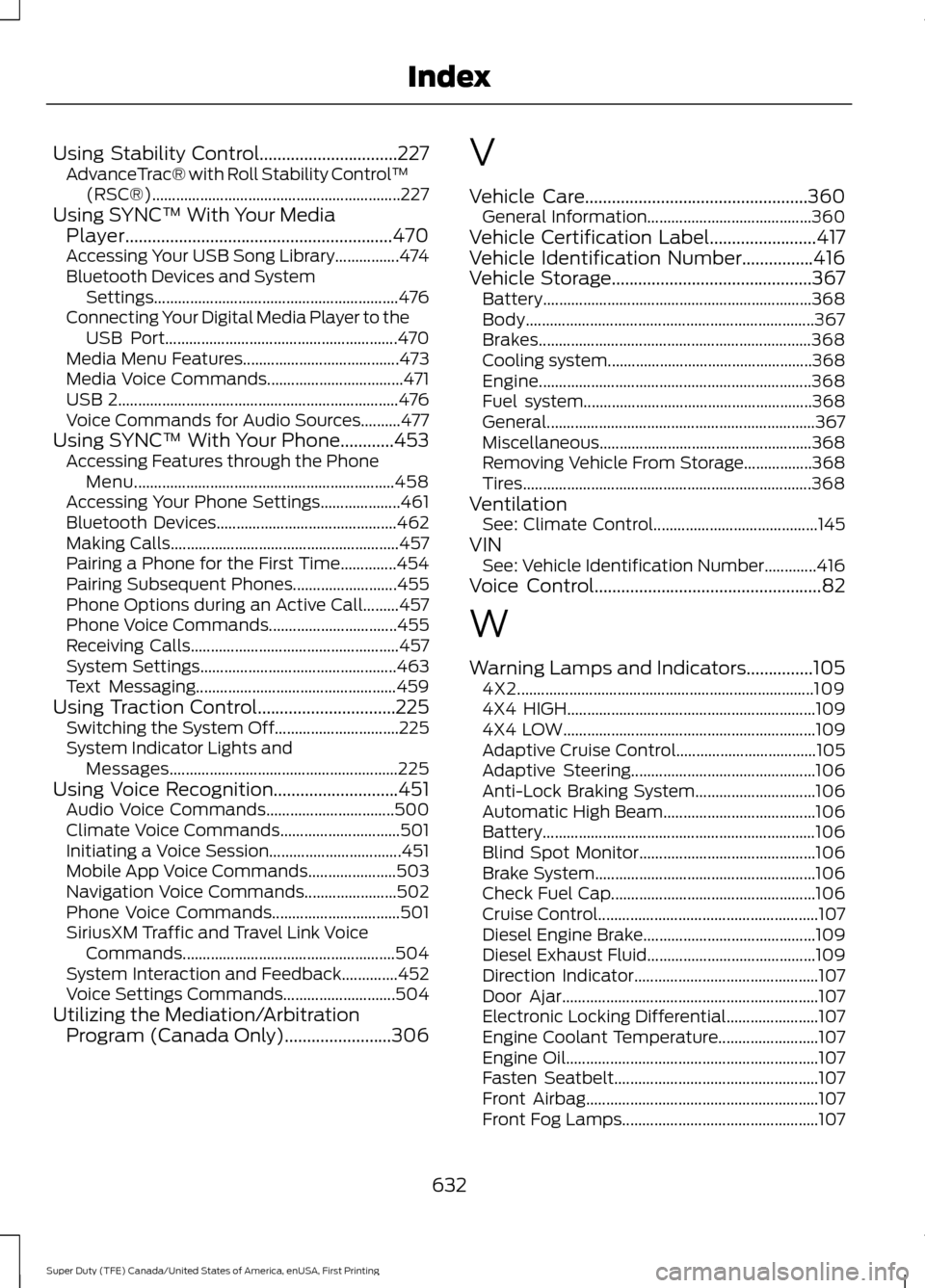
Using Stability Control...............................227
AdvanceTrac® with Roll Stability Control ™
(RSC®).............................................................. 227
Using SYNC™ With Your Media Player............................................................470
Accessing Your USB Song Library................474
Bluetooth Devices and System Settings............................................................. 476
Connecting Your Digital Media Player to the USB Port.......................................................... 470
Media Menu Features....................................... 473
Media Voice Commands.................................. 471
USB 2...................................................................... 476
Voice Commands for Audio Sources..........477
Using SYNC™ With Your Phone............453 Accessing Features through the Phone
Menu................................................................. 458
Accessing Your Phone Settings....................461
Bluetooth Devices............................................. 462
Making Calls......................................................... 457
Pairing a Phone for the First Time..............454
Pairing Subsequent Phones.......................... 455
Phone Options during an Active Call.........457
Phone Voice Commands................................ 455
Receiving Calls.................................................... 457
System Settings................................................. 463
Text Messaging.................................................. 459
Using Traction Control...............................225 Switching the System Off............................... 225
System Indicator Lights and Messages......................................................... 225
Using Voice Recognition............................451 Audio Voice Commands................................ 500
Climate Voice Commands.............................. 501
Initiating a Voice Session................................. 451
Mobile App Voice Commands...................... 503
Navigation Voice Commands.......................502
Phone Voice Commands................................ 501
SiriusXM Traffic and Travel Link Voice Commands..................................................... 504
System Interaction and Feedback..............452
Voice Settings Commands............................ 504
Utilizing the Mediation/Arbitration Program (Canada Only)........................306 V
Vehicle Care..................................................360
General Information......................................... 360
Vehicle Certification Label
........................417
Vehicle Identification Number................416
Vehicle Storage
.............................................367
Battery................................................................... 368
Body........................................................................\
367
Brakes.................................................................... 368
Cooling system................................................... 368
Engine.................................................................... 368
Fuel system......................................................... 368
General................................................................... 367
Miscellaneous..................................................... 368
Removing Vehicle From Storage.................368
Tires........................................................................\
368
Ventilation See: Climate Control......................................... 145
VIN See: Vehicle Identification Number.............416
Voice Control
...................................................82
W
Warning Lamps and Indicators...............105 4X2........................................................................\
.. 109
4X4 HIGH.............................................................. 109
4X4 LOW............................................................... 109
Adaptive Cruise Control................................... 105
Adaptive Steering.............................................. 106
Anti-Lock Braking System.............................. 106
Automatic High Beam...................................... 106
Battery.................................................................... 106
Blind Spot Monitor............................................ 106
Brake System....................................................... 106
Check Fuel Cap................................................... 106
Cruise Control....................................................... 107
Diesel Engine Brake........................................... 109
Diesel Exhaust Fluid.......................................... 109
Direction Indicator.............................................. 107
Door Ajar................................................................ 107
Electronic Locking Differential....................... 107
Engine Coolant Temperature.........................107
Engine Oil............................................................... 107
Fasten Seatbelt................................................... 107
Front Airbag.......................................................... 107
Front Fog Lamps................................................. 107
632
Super Duty (TFE) Canada/United States of America, enUSA, First Printing Index